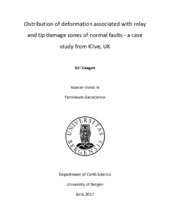| dc.description.abstract | The aim of this study is to investigate and characterize distribution of deformation and damage associated with relays and tips of normal faults at a range of scales. This is done through field based studies and digital analysis of aerial imagery of exposed wave-cut platforms along the Somerset coast, UK. Damage zones have earlier been described geometrically and spatially, but a systematic quantification of deformation (i.e. displacement, strain etc.) is lacking. Damage at different scales (i.e. large faults, small faults and veins) is thus quantified to investigate the partitioning of deformation between different structures, and document damage zone complexity and spatial variation. The study provides new insight regarding brittle deformation at different scaled fault interactions, single faults and fault related veining, specifically focusing on distribution of deformation, partitioning of strain and spatial heterogeneity within relays and tip damage zones. The results show that within studied fault networks, damage zones are widest and show highest vein intensity and vein strain in areas of fault interaction (i.e. relay zones, fault splays, cross-cutting or abutting relationships) and at fault tips. Mapping of relay structures shows a decrease in displacement of relay bounding faults as they overlap, which is compensated by the introduction of linkage damage structures that transfer displacement (~45 %), so that kinematic coherency is maintained. This illustrate that strain compatibility remains within relay zones, even though the partitioning of strain between different structures is changing through the zone. Fault tip zones are characterized by a wide process zone in the outer tip, exchanged by a narrow damage zone where significant slip occurs. This shows that damage zone width decreases with increased displacement, indicating that deformation becomes more localized as the fault accumulates slip. This is supported by spatial heterogeneity analyses of deformation over both relay structures and fault tips, showing that deformation changes from distributed to localized moving away from the damage zones. This results in a decrease in structure complexity as deformation localizes onto the main faults. These findings highlight the importance of documenting and quantifying small-scale structures of damage zones, because they are often under seismic resolution and represent structural complexities that might have implication on fluid flow and rock permeability. | en_US |
